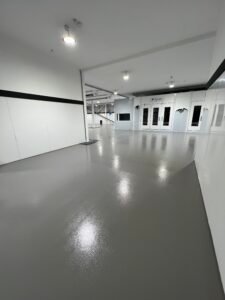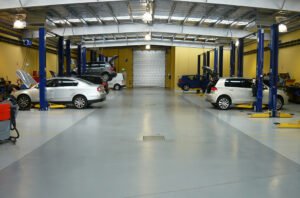Epoxy flooring is known for its strength, longevity, and sleek, seamless finish. It’s widely used across commercial, industrial, and residential environments due to its resistance to wear, chemicals, and moisture. But despite these advantages, epoxy is not a one-size-fits-all solution. There are specific circumstances where epoxy may not be the most suitable choice, and understanding these can save you time, money, and potential headaches.
At Resinate Flooring, we believe in delivering honest advice as well as high-quality finishes. In this article, we explore when you should not use epoxy and what alternatives may be more appropriate for your space.
- When the Surface Is Damp or Moisture-Prone
Epoxy flooring requires a dry, moisture-free surface for proper adhesion. If the underlying concrete is damp or exposed to ongoing moisture issues—whether from rising damp, leaks, or condensation—epoxy will likely fail over time.
Why This Matters:
Moisture prevents the epoxy from bonding properly to the substrate. Over time, this can cause the coating to bubble, lift, or peel—resulting in a poor finish and costly repairs.
What to Consider:
Before installation, moisture testing is essential. At Resinate Flooring, we perform thorough inspections and use moisture meters to ensure the subfloor is suitable. If not, a moisture barrier or alternative flooring may be recommended.
- When Exposed to Direct, Prolonged Sunlight
Standard epoxy coatings are not UV-stable. In areas with direct exposure to sunlight, such as outdoor patios, driveways, or rooms with large south-facing windows, epoxy can fade, yellow, or discolour over time.
Why This Matters:
UV degradation not only affects aesthetics but can also weaken the surface integrity of the epoxy. This is especially problematic in decorative applications where appearance is a priority.
What to Consider:
If the area is subject to sunlight, a UV-resistant topcoat or polyaspartic coating may be more suitable. These provide better colour retention and protection against degradation.
- In Environments With Constant High Temperatures
While epoxy is heat-resistant to a point, it’s not the best choice for areas with constant high temperatures—such as near industrial ovens, commercial kitchens with poor ventilation, or outdoor areas in hot climates.
Why This Matters:
Prolonged exposure to high heat can cause epoxy to soften or become brittle, leading to premature wear or surface cracking.
What to Consider:
If heat is a factor, consider materials like polyurethane or cementitious urethane, which are more resilient under temperature fluctuations.
- On Unstable or Cracked Subfloors
Epoxy is rigid once cured. If it’s applied to a surface that’s uneven, cracked, or prone to structural movement, the epoxy will mirror those flaws or become damaged as the surface shifts.
Why This Matters:
Concrete slabs that move, expand, or contract significantly can cause epoxy to delaminate or split, affecting both appearance and performance.
What to Consider:
Subfloor repair and levelling are crucial. At Resinate Flooring, we offer full surface preparation services to address imperfections before applying epoxy. In some cases, flexible floor systems or other coatings may be more appropriate.
- If a Quick Turnaround Time Is Essential
Epoxy flooring isn’t an instant solution. It typically requires multiple layers and curing time between each coat, followed by a final curing period before the floor can be used. Depending on the size of the space and environmental conditions, installation can take several days.
Why This Matters:
In businesses or facilities that can’t afford downtime, such as retail shops, hospitals, or production lines, the extended curing time can pose significant disruptions.
What to Consider:
Fast-curing alternatives like polyaspartic or methyl methacrylate (MMA) coatings may be more suitable when time is of the essence. Our team can advise on the best solution to minimise business disruption.
- In Spaces Requiring Frequent Redesign or Removal
Epoxy flooring is designed to be semi-permanent. It bonds tightly to the substrate and is difficult to remove without professional tools and considerable labour. If you’re flooring a temporary space, pop-up venue, or rental unit where frequent redesign is needed, epoxy may not be the best option.
Why This Matters:
Removing epoxy can be labour-intensive and may damage the concrete underneath, making surface repair necessary.
What to Consider:
In such cases, modular flooring, vinyl tiles, or interlocking mats can offer flexibility and ease of removal.
- On Surfaces with Contaminants or Poor Preparation
Epoxy requires a clean, properly prepared surface for successful application. If the concrete is contaminated with oil, grease, or existing coatings, and not properly cleaned or ground beforehand, the epoxy will not adhere correctly.
Why This Matters:
Poor surface preparation is one of the leading causes of epoxy floor failure. The result is peeling, bubbling, or flaking soon after installation.
What to Consider:
Always choose professional epoxy installers who specialise in preparation. At Resinate Flooring, our preparation process includes grinding, cleaning, and moisture testing to ensure optimal adhesion and longevity.
Frequently Asked Questions
Can epoxy flooring be used outside?
While possible, standard epoxy isn’t ideal for exterior use due to its sensitivity to UV rays and moisture. For outdoor applications, we recommend UV-resistant coatings or other weatherproof solutions.
What happens if epoxy is applied to a damp floor?
If applied to a damp surface, epoxy may not bond properly, leading to blistering, bubbling, or peeling. Moisture testing is essential before application.
Are there alternatives to epoxy flooring?
Yes. Alternatives include polyurethane, polyaspartic, and MMA coatings, each with different properties suited to various environments. Our team can help you choose the best option for your needs.
Can epoxy flooring be removed later?
Yes, but it’s difficult and usually requires grinding or shot blasting. It’s not suitable for areas where flooring flexibility or easy removal is necessary.
Conclusion
Epoxy flooring offers a host of benefits—from durability to visual appeal—but it’s not suitable for every situation. Conditions such as moisture issues, UV exposure, structural instability, and the need for quick turnaround can all present challenges. At Resinate Flooring, we prioritise long-term performance and customer satisfaction, which means helping you determine whether epoxy is the right fit—or if another flooring solution would serve you better.
If you’re unsure whether epoxy is suitable for your space, contact Resinate Flooring for professional advice and tailored recommendations.







